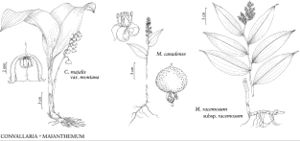Convallaria
Sp. Pl. 1: 314. 1753.
Gen. Pl. ed. 5, 383. 1754.
| Taxon | Illustrator ⠉ | |
|---|---|---|
 | Convallaria majalis var. montana Maianthemum canadense Maianthemum racemosum subsp. racemosum | Yevonn Wilson-Ramsey Yevonn Wilson-Ramsey Yevonn Wilson-Ramsey |
Herbs, perennial, scapose, from slender, branched rhizomes with upright buds (pips); forming colonies. Leaves 2–3, basal, erect, sheathing, petiolate; petiole erect, slender; blade oblong to widely elliptic, glabrous, apex acute to acuminate. Scape arising basally. Inflorescences racemose, 5–15-flowered, bracteate; raceme 1-sided, 1–3 dm; bracts subtending pedicel. Flowers deciduous, nodding, very fragrant; perianth globose-campanulate; tepals almost completely connate, distinct lobes outwardly recurved; stamens 6, included, attached at perianth-tube base; anthers oblong to lanceolate, introrse; ovary superior, 3-locular, syncarpous, ovules 4–8 per locule; septal grooves absent; style included, connate, straight; stigmas weakly 3-lobed to capitate; pedicel recurved, filiform. Fruits baccate, orangish red, globose, pulpy. Seeds yellow to light-brown, subglobose to angled, smooth. x = 19.
Distribution
n temperate North America and Eurasia
Discussion
Species 1.
As described here, Convallaria may be viewed as monotypic with three (or more) isolated infraspecific taxa, or else as three morphologically similar but isolated species (B. E. Streveler 1966). Our native taxon, Convallaria majalis var. montana, is more closely related to that in eastern Asia, var. keiskei (Miquel) Makino (= C. keiskei Miquel), than to that of western Europe, var. majalis (M. L. Fernald 1928c, 1944c). While the genus is well known for its sweet fragrance, potential poisonings are a concern due to the more than 38 cardenolide glycosides (G. E. Burrows and R. J. Tyrl 2001), including convallatoxin, found throughout these ornamentals (W. H. Lewis and M. P. F. Elvin-Lewis 1977).
Selected References
None.
Lower Taxa
"broad" is not a number."dm" is not declared as a valid unit of measurement for this property."thicker" is not a number.